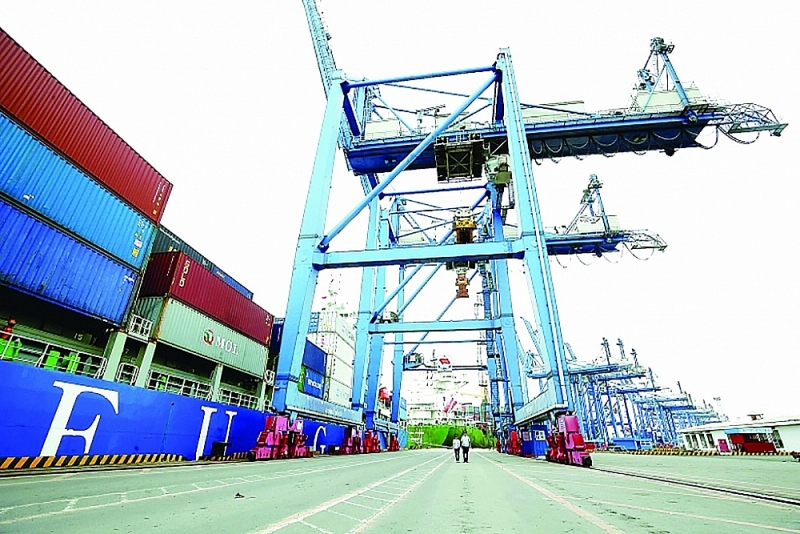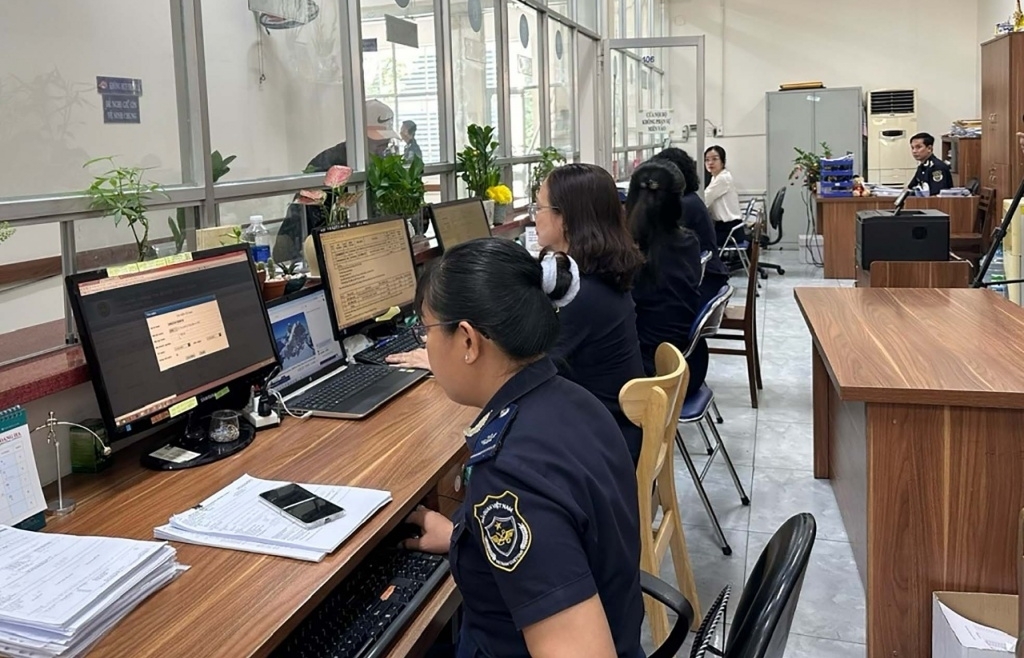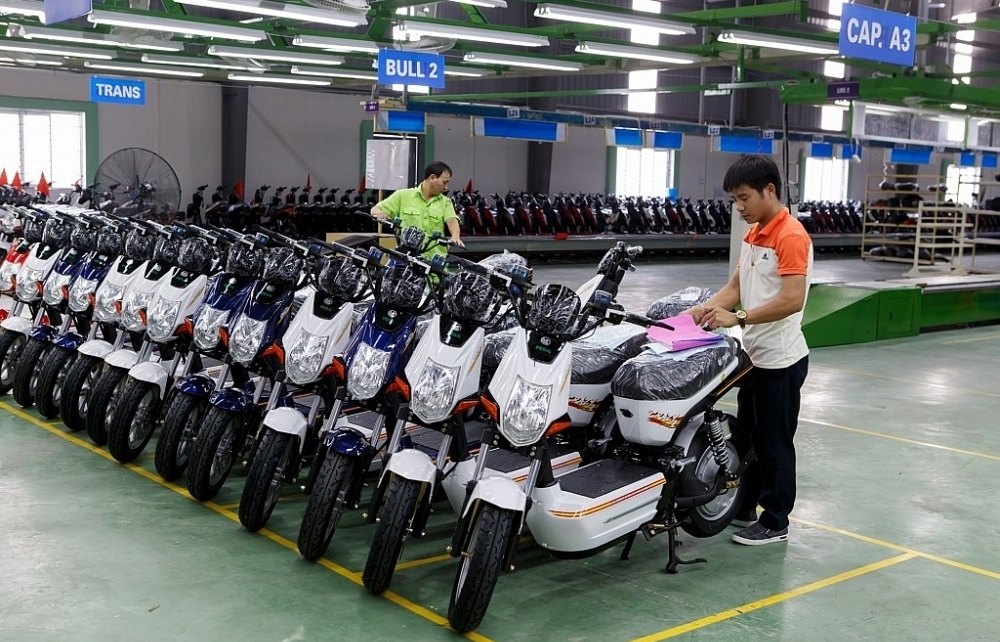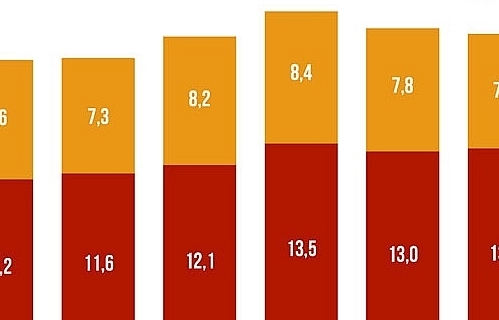Commodity export marked in 2011-2020: From trade deficit to trade surplus
 |
| Vietnam is one of the countries with the highest average export growth in the world and the region in the 2011-2020 period. Photo: Huy Kham |
Spectacular reserve
| During the implementation of the Commodity Import-Export Strategy 2011-2021, the growth rate of export turnover reached an average of 17.5% per year in the period 2011-2015 (higher than the set target of 12% per year).; reaching 11.8%/year in the period 2016-2020 (higher than the set target of 11%/year). For the whole period 2011-2020, the average growth rate of commodity export turnover reached 14.6% per year (higher than the target set by the Strategy of 11-12% per year). Regarding imports, during the implementation of the strategy, the import growth rate was always lower than the export growth rate set by target. Accordingly, the growth rate of import turnover reached 14.3% per year in the period 2011-2015 (lower than the export growth rate of 17.5% per year), reached 9.7% per year in the period 2016-2020 (lower than the export growth rate of 11.8% per year). For the whole period 2011-2020, the growth rate of goods import turnover reached 11.9% per year (lower than the export growth rate of 14.6% per year). |
Talking about results achieved in the import and export of goods in the 2011-2020 period, many bright spots can be mentioned.
However, the most outstanding feature that depicts the complete difference compared to the previous period is the spectacular transformation of the trade balance from a persistent trade deficit to a continuous trade surplus.
Talking to a reporter of Customs News, Dr. Le Quoc Phuong, former Deputy Director of the Center for Industry and Trade Information (Ministry of Industry and Trade), said: “From 1986 to 2011, Vietnam was a chronic trade deficit country. Even in the 2007-2011 period, Vietnam's trade deficit exceeded US$10 billion per year. Notably, in 2008, Vietnam had a record trade deficit of nearly US$20 billion. After that, Vietnam switched to a continuous trade surplus from 2012 (except for 2015). In particular, Vietnam's trade surplus of next year will increase higher than the previous year, far exceeding the strategic target set out to balance the trade balance by 2020 and strive for a trade surplus from 2021.”
This expert further said: “In the context of "shocks" from the outside and also internal difficulties, it is remarkable that import and export in the past 10 years still achieved high results. Vietnam's commodity groups are even among the "top" in the world such as rice, coffee, cashew nuts, aquatic products, textiles, footwear.”
Similarly, Assoc. Prof. Dr. Pham Tat Thang, Senior Researcher of the Institute of Industry and Trade Strategy and Policy (Ministry of Industry and Trade), also highly appreciated the export and import results over the past 10 years. He said: “The number of items with export turnover of US$1 billion per year has increased significantly. This shows that Vietnam has focused on a few key products, not just spreading on a larger scale. Besides, the form of export has seen many changes, promoting trade with focus, building a good value-added chain and bringing goods into foreign distribution systems.”
Looking back at the overall implementation of the strategy, the Ministry of Industry and Trade said the results achieved exceeded many set targets, such as the target on scale and growth rate of import-export turnover, reducing the trade deficit. The general objective set out in the strategy is: “Total export turnover of goods by 2020 will more than triple that of 2010, per capita will reach over US$2,000, the trade balance will be balanced”.
In fact, the export turnover of goods in 2020 reached US$282,655 million, an increase of 3.9 times compared to 2010 (US$72,236 million). Export turnover of goods per capita increased rapidly, from US$822 in 2010 to US$2,891 in 2020 (up 3.5 times compared to 2010). The trade balance has completely turned into a surplus since 2016, with a trade surplus of US$19.9 billion in 2020.
In addition, the representative of the Ministry of Industry and Trade also said that the structure of export goods had seen positive changes, increasing the proportion of manufactured goods, reducing the proportion of preliminarily processed raw materials. Major export products such as textiles and garments, footwear, wood products, machinery, equipment and spare parts continued to maintain stable growth, and developing many new export products in the technology group such as mobile phones, computers and electronic devices.
Weakness: too dependent on FDI
Affirming that the import-export results achieved in the period 2011-2020 were very positive, however, expert Le Quoc Phuong also said: “It's all just the surface. Looking deeper under the surface there are a lot of problems.”
He said that the export achievements in terms of quantity and growth quality was still low. Currently, the added value of Vietnam's exports was lower than that of many ASEAN countries such as Singapore, Indonesia, Malaysia, Thailand, and the Philippines. In addition, the export structure had shifted rapidly in the direction of increasing the proportion of processed and manufactured industrial products, but most of the products were processed and assembled, from clothes, shoes, bags to mobile phones, televisions, computers, cameras, cars, motorbikes.
“Vietnam’s benefits from exports are small, mainly simple work, low-skilled workers and rental fees of land, factories, selling natural resources or services to foreign enterprises,” said Mr. Le Quoc Phuong.
Many economic experts shared the same view that Vietnam's export performance was impressive, but it depended too much on foreign-invested enterprises (FDI). The role of domestic enterprises was increasingly inferior. The proportion of FDI enterprises in exports in 2010 was 54%, it was 72% by 2020 and in the first nine months of 2021 this figure was 74%. At the same time, the proportion of Vietnamese enterprises had decreased from 46% in 2010 to 28% in 2020.
“The competitiveness and ability of Vietnamese enterprises to participate in the global value chain is still low. This is the root of the problem. This problem has been improved in the past 10 years, but it is far from meeting the requirements and expectations,” said Mr. Le Quoc Phuong.
The Ministry of Industry and Trade also noted the outstanding limitations and weaknesses in import and export in the past 10 years, which was that export growth had reached a high rate, but it was not really sustainable in the medium and long term, there are many potential risks that could affect stable export growth. Those risks came from the imbalance in the trade balance with markets; the imbalance in the export market; the imbalance in the structure of export enterprises and the imbalance in the structure of export goods.
Particularly from the perspective of exports being too dependent on the FDI sector, a representative of the Ministry of Industry and Trade said: “The increase in exports of the FDI sector shows the weak competitiveness of the domestic economic sector. Excessive dependence on FDI also poses risks to exports, especially in the context of large external fluctuations.”
Switching growth from quantity to quality
In the future, in order to promote fast commodity export growth and sustainable export surplus, Le Quoc Phuong said that the key was to switch from export growth in quantity to quality; focus on enhancing added value, switch from a processing and exporting economy to a manufacturing and exporting economy; technological exports must have a high localization rate.
“The main support for fast and sustainable export growth is domestic enterprises. In the immediate period, it is necessary to strongly develop supporting industries, helping to increase the localization rate. In addition, many other solutions must be synchronously implemented, such as continue to promote trade promotion, diversify export markets, make good use of FTAs, reform administrative procedures and improve the business environment. to create more favorable conditions for enterprises,” said expert Le Quoc Phuong.
At a more macro level, according to Dr. Nguyen Dinh Cung, former Director of the Central Institute for Economic Management (CIEM), in recent years, Vietnam’s import-export turnover had increased rapidly and was now at a high level, making the openness of the economy have a response increase (over 200% and increasing rapidly).
The large openness, large and disproportionate dependence on a few partners, especially China and the United States, would create more and more complicated risks, making the economy less resilient and vulnerable to adverse external influences.
In order to overcome the disadvantages of opening the economy, economic institutions must reform and fundamentally change in the direction of encouraging and promoting rapid, strong and sustainable development of the domestic economic sector, first of all the private economy; and at the same time attract FDI (large scale) directly from the US and EU.
Related News

Numerous FDI enterprises face suspension of customs procedures due to tax debt
09:57 | 18/12/2024 Anti-Smuggling

State revenue collection poised to surpass annual target
10:11 | 12/11/2024 Finance

Import and export rose by more than US$81 billion by the end of September
15:32 | 20/10/2024 Import-Export

Customs sector has collected VND 300 trillion to state budget in 9 months
09:22 | 06/10/2024 Customs
Latest News

VN faced with increasing trade defence investigations on rising protectionism
18:58 | 22/12/2024 Import-Export

Việt Nam expects to officially export passion fruit to the US next year
18:55 | 22/12/2024 Import-Export

UK’s carbon tax to affect VN exports
18:51 | 22/12/2024 Import-Export

Removing obstacles in granting certificates of exploited aquatic products
13:56 | 22/12/2024 Import-Export
More News

Promoting agricultural exports to the Japanese market
13:55 | 22/12/2024 Import-Export

Agricultural exports in 2024 to exceed 60 billion USD?
13:53 | 22/12/2024 Import-Export

Seafood exports expected to exceed $10 billion in 2025: expert
20:28 | 21/12/2024 Import-Export

Top 10 Reputable Animal Feed Companies in 2024: Efforts to survive the challenges of nature
18:30 | 21/12/2024 Import-Export

Vietnam's import-export surges 15.3%
09:44 | 20/12/2024 Import-Export

More Vietnamese firms interested in Saudi Arabia: Ambassador
09:43 | 20/12/2024 Import-Export

“Give and Take” in the Value Chain of the CPTPP Market
09:30 | 20/12/2024 Import-Export

Binh Dinh province works to attract investment from Japan
15:44 | 19/12/2024 Import-Export

Agricultural, forestry and fishery exports “reach the target” early
15:20 | 19/12/2024 Import-Export
Your care

VN faced with increasing trade defence investigations on rising protectionism
18:58 | 22/12/2024 Import-Export

Việt Nam expects to officially export passion fruit to the US next year
18:55 | 22/12/2024 Import-Export

UK’s carbon tax to affect VN exports
18:51 | 22/12/2024 Import-Export

Removing obstacles in granting certificates of exploited aquatic products
13:56 | 22/12/2024 Import-Export

Promoting agricultural exports to the Japanese market
13:55 | 22/12/2024 Import-Export





